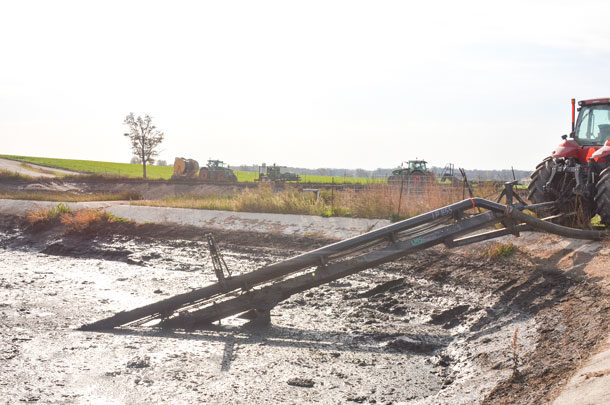Safe and secure manure storage is very important on your dairy. In order to maximize contents during the growing season, manure pits must be agitated and pumped out regularly. Although on some operations this task only happens a few times a year, planning ahead, developing safe operating procedures and ensuring everyone is trained on manure pit safety will help keep employees and anyone else that may be on the farm safe. Let’s take a moment to examine some of the common hazards.
Avoid entering any manure storage area
The best practice is to never enter a manure pit. Every time you enter a manure pit, you should treat it as a potentially lethal space. Just because you may have entered a pit in the past without incident doesn’t mean you can do so again now. There’s no way to know how conditions might have changed or what gases have built up since the last time. As such, you need to be prepared for anything.
Avoid the need to enter a manure pit, but if you must, be sure to use the appropriate testing equipment to test the environment prior to entry and wear the appropriate personal protective equipment (PPE), which may include a supplied air respirator or self-contained breathing apparatus. You must also have two monitors (people) posted in a safe location nearby with their own PPE and adequate rescue equipment to ensure that a quick and safe evacuation can be performed if needed.
Be aware of the hazards and risks
- Risk of falling into manure and drowning – Equipment and vehicle operators can drive into manure storage ponds, lagoons and pits. Earthen edges around basins, ponds or lagoons may appear deceptively solid or become invisible to workers when edges blend in with surroundings. Risks also increase during low-light conditions, for example, during evening work or in poorly lit areas. Tractor-scraper drivers can tumble into pit openings from push-off platforms or ramps. Individuals walking or working at ground level near boundaries of pits, separator lagoons and sometimes other types of manure storage can also stumble and fall into manure. Ladder use, especially if the ladder is unstable or poorly maintained, can also cause falls into pits. Ladders used to access underground pumps and other areas can also pose a significant fall hazard. Fall protection must be used for ladders if there is a risk of falling.
-
Manure gases can suffocate, poison or ignite – Of all the hazards,
manure pit gases are considered one of the biggest concerns for health
and safety around manure handling and storage. Manure pit gases from any
storage pit, whether closed, open or under-barn storage, can be toxic
to both humans and livestock.
Stored manure consumes oxygen and releases hazardous gases, including hydrogen sulphide, carbon dioxide, methane and ammonia. The combination of low oxygen and accumulated gases above the manure can swiftly overcome workers and farmers without warning. Atmospheric conditions in and around pits and other manure containment may be safe on some days and deadly on others. Don’t rely on past luck with uneventful entries. Your sense of smell will not keep you safe from manure gases. Risk for harm is generally higher in enclosed or confined structures like tanks or pits.
High levels of manure gas are released during activities that disturb the manure, such as pumping and agitating it. These gases can enter attached barns or adjacent buildings, so adequate ventilation is very important. Even sludge and residue at the bottom of drained pits, tanks and other containers can emit dangerous amounts of manure gases. Gas production will increase at warmer temperatures. Some manure gases, like methane, are potentially ignitable and explosive.
Keep in mind that toxic gas and low oxygen levels can be present near manure pumps, in confined spaces and in other equipment areas as well. Ensure proper monitoring is used before entering any confined space, including underground pump areas.
-
Moving parts on machinery and equipment – Workers are at risk for amputations, broken bones, getting crushed and other severe injuries when working around manure pumps, agitators and rotating shafts (e.g., power-takeoffs/PTOs). These and other hazard sources can quickly snag and draw in workers’ loose clothing, long hair, jewelry, fingers or feet. Before working on any equipment or going near any pumps or other machinery, make sure the equipment is locked out.
- Bacteria and other pathogens – Solid or liquid manure harbors pathogens that can cause infection or illness through direct contact. Getting splashed in the eye or mouth may transmit pathogens and cause serious infection.
Prevent drownings
Ask yourself, have we implemented the following: Make manure pit, pond, basin and lagoon boundaries visible. Put up a safety fence or block off boundaries to prevent unsafe access. Lock gates and access to ensure safety. Add appropriate safety covers for tanks and access openings to manure pits and other confined spaces to keep people out. Post and maintain appropriate warning signs around manure storage. Use reflective tape or bright paint for better visibility in low light.
Prevent rescuers from becoming additional victims. Make plans on what to do should emergency rescue become necessary. Any individual involved in rescue or retrieval must have special training and equipment and follow all applicable safety procedures. Ensure that everyone on the dairy has been trained on this procedure by reviewing and discussing the safe operating procedure as well as conducting annual refresher training. Document this training.
Prevent manure gas deaths
A key prevention solution is to ensure effective ventilation is in place. Mechanical ventilation may be necessary to replenish oxygen and remove hazardous manure gases, especially when manure is being agitated or pumped. Keep in mind that ventilation may not always be enough. If workers must enter pits, tanks, other manure storage areas or other areas where gas may accumulate, you should purchase or rent the appropriate air/gas monitoring equipment. Follow established procedures on how to safely and effectively conduct gas monitoring before any entry.
Prevent other injuries and illnesses
- Mechanical: Ensure barriers/guards that cover dangerous moving parts are in place. Keep all safeguards in place and maintained. Review as a team how machinery and equipment, such as pumps and agitators, can harm a worker. Discuss and review proper lockout/tagout procedures and how to safely start up, use, shut off, unclog, retrieve, clean and repair equipment. Provide locks and other safety equipment. Follow safety guidance specific to the equipment being used.
- Pathogens: Stay clear of activities that agitate and splash manure solids or liquids. When contact with manure is unavoidable, wear proper safety gear such as eye protection and face shields that can prevent splashed manure from contacting your eyes and mouth. Other PPE, like coveralls and gloves, can prevent pathogens from infecting skin and causing health problems. Always follow correct handwashing techniques and other hygiene practices that help reduce the spread of contamination to food, eyes and work surfaces.
Safety precautions when agitating manure pits
- Do not enter the barn while manure is being agitated in the pit below. Instruct workers and all visitors on the farm to stay out of the building while manure is being pumped and agitated.
- If possible, use signage or lockout tags to remind everyone of the activity taking place.
- Ensure adequate ventilation in all enclosed areas, such as barns, that may have a build-up of gas during agitation and pumping. Natural ventilation may not be enough. If possible, use mechanical ventilation. Set ventilation rates at the maximum level and adjust fresh air inlets to meet the needs of the barn’s exhaust fans. When using mechanical ventilation, you should avoid opening doors and windows that are not normal fresh-air inlets, unless you have planned for this change, since the unplanned area of incoming air may short circuit the system, causing stagnant areas with little or no air movement.
- Be extremely cautious if manure in the pit is foaming. Foam contains high levels of methane, and agitating manure will break the foam bubbles, resulting in methane build-up in the building that can cause fires and explosions.
PPE
If you must enter manure storage, you’ll need to wear the following PPE: self-contained breathing apparatus, safety harness with lifeline, eye protection and face shields, and coveralls and gloves.
At least two other personnel should be on hand to assist in a rescue, if necessary. At no point should a rescuer enter a pit without proper breathing equipment, otherwise he or she runs the risk of becoming a victim too. Prior to a worker entering the pit, discuss as a team what emergency steps you will take should the worker get in trouble while in the pit. Document the steps and have each worker sign off on this document.
Signage
Post signage at applicable manure pits as a visual reminder for all workers and visitors to the dairy.
By following these steps and by having everyone take part in ensuring a workplace safe from manure-pit hazards, we can help keep our entire team safe.










